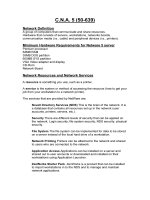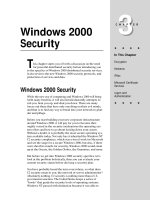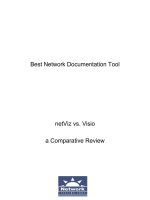Tài liệu Constructing network security monitoring systems: MOVERTI Deliverable V9 docx
Bạn đang xem bản rút gọn của tài liệu. Xem và tải ngay bản đầy đủ của tài liệu tại đây (525.49 KB, 57 trang )
VTT RESEARCH NOTES 2589
• • • VTT RESEARCH NOTES 2589 CONSTRUCTING NETWORK SECURITY MONITORING SYSTEMS (MOVERTI DELIVERABLE V9)
ISBN 978-951-38-7769-9 (URL: .fi/publications/index.jsp)
ISSN 1455-0865 (URL: .fi/publications/index.jsp)
VTT Tiedotteita – Research Notes
2574 Marko Jurvansuu. Roadmap to a Ubiquitous World. Where the Difference Between
Real and Virtual Is Blurred. 2011. 79 p.
2575 Towards Cognitive Radio Systems. Main Findings from the COGNAC project. Marja
Matinmikko & Timo Bräysy (eds.). 2011. 80 p. + app. 23 p.
2576 Sebastian Teir, Antti Arasto, Eemeli Tsupari, Tiina Koljonen, Janne Kärki, Lauri
Kujanpää, Antti Lehtilä, Matti Nieminen & Soile Aatos. Hiilidioksidin talteenoton
ja varastoinnin (CCS:n) soveltaminen Suomen olosuhteissa. 76 s. + liitt. 3 s.
2577 Teuvo Paappanen, Tuulikki Lindh, Risto Impola, Timo Järvinen & Ismo Tiihonen,
Timo Lötjönen & Samuli Rinne. Ruokohelven hankinta keskisuomalaisille
voimalaitoksille. 2011. 148 s. + liitt. 5 s.
2578 Inka Lappalainen, Ilmari Lappeteläinen, Erja Wiili-Peltola & Minna Kansola.
MULTIPRO. Vertaileva arviointi¬konsepti julkisen ja yksityisen hyvinvointipalvelun
arviointiin. 2011. 64 s.
2579 Jari Kettunen, Ilkka Kaisto, Ed van den Kieboom, Riku Rikkola & Raimo Korhonen.
Promoting Entrepreneurship in Organic and Large Area Electronics in Europe.
Issues and Recommendations. 2011. 69 p. + app. 7 p.
2580 Оса Нюстедт, Мари Сеппонен, Микко Виртанен,Пекка Лахти, Йоханна Нуммелин,
Сеппо Теэримо. ЭкоГрад. Концепция создания экологически эффективного района
в Санкт-Петербурге. 2011. 89 с. + прил. 12 c.
2581 Juha Forsström, Pekka Lahti, Esa Pursiheimo, Miika Rämä, Jari Shemeikka, Kari
Sipilä, Pekka Tuominen & Irmeli Wahlgren. Measuring energy efficiency Indicators
and potentials in buildings, communities and energy systems. 2011. 107 p. +
app. 5 p.
2582 Hannu Hänninen, Anssi Brederholm, Tapio Saukkonen, Mykola Evanchenko, Aki
Toivonen, Wade Karlsen, Ulla Ehrnstén & Pertti Aaltonen. Environment-assisted
cracking and hot cracking susceptibility of nickel-base alloy weld metals. 2011.
VTT, Espoo. 152 p.
2583 Jarmo Alanen, Iiro Vidberg, Heikki Nikula, Nikolaos Papakonstantinou, Teppo
Pirttioja & Seppo Sierla. Engineering Data Model for Machine Automation 2011.
131 p.
2584 Maija Ruska & Juha Kiviluoma. Renewable electricity in Europe. Current state,
drivers, and scenarios for 2020. 2011. 72 p.
2585 Paul Buhanist, Laura Hakala, Erkki Haramo, Katri Kallio, Kristiina Kantola, Tuukka
Kostamo & Heli Talja. Tietojärjestelmä osaamisen johtamisessa – visiot ja käytäntö.
2011. 36 s.
2589 Pasi Ahonen. Constructing network security monitoring systems (MOVERTI
Deliverable V9). 2011. 52 p.
VTT CREATES BUSINESS FROM TECHNOLOGY
Technology and market foresight • Strategic research • Product and service development • IPR and licensing
• Assessments, testing, inspection, certification • Technology and innovation management • Technology partnership
Pasi Ahonen
Constructing network security
monitoring systems
MOVERTI Deliverable V9
VTT TIEDOTTEITA – RESEARCH NOTES 2589
Constructing network security
monitoring systems
MOVERTI Deliverable V9
Pasi Ahonen
MOVERTI – Monitoring for network security status in modern data networks
(A project funded within TEKES Safety and Security Program)
ISBN 978-951-38-7769-9 (URL:
ISSN 1455-0865 (URL:
Copyright © VTT 2011
JULKAISIJA – UTGIVARE – PUBLISHER
VTT, Vuorimiehentie 5, PL 1000, 02044 VTT
puh. vaihde 020 722 111, faksi 020 722 4374
VTT, Bergsmansvägen 5, PB 1000, 02044 VTT
tel. växel 020 722 111, fax 020 722 4374
VTT Technical Research Centre of Finland, Vuorimiehentie 5, P.O. Box 1000, FI-02044 VTT, Finland
phone internat. +358 20 722 111, fax +358 20 722 4374
3
Pasi Ahonen. Constructing network security monitoring systems (MOVERTI Deliverable V9). Espoo
2011. VTT Tiedotteita 2589. 52 p.
Keywords network security, monitoring systems, data networks
Abstract
This report analyses and describes the basic construction of network security
monitoring systems. The viewpoint is mainly research perspective, we aim for
defining system constructions or elements which are also commercially relevant,
but still maintain the open minded approach of research oriented work. The fo-
cus is on clarifying the overall network security follow up, but also on methods
for investigating the “difficult to identify” or zero-day attacks or the preparation
of such attacks, which try to exploit the application vulnerabilities that are cur-
rently unknown to operators and software developers.
The necessary network security system construction depends much on the op-
erator’s targets for security monitoring. The threat environment of some specific
operator may require a deeper analysis of the output from various security de-
vice logs, events and alarms. The needs of such operator may be to adjust the
different alarm thresholds for the security devices accurately, according to the
evolving network data traffic characteristics. Another operator, instead, would
require holistic security monitoring of the production area, where e.g. the status
information within physical access control systems and electronic access control
systems shall be combined, and the aggregated summary results shall be pre-
sented to the operator for sanity checking.
Therefore, we present in this report some building blocks that can be used to
construct a security monitoring system, not a complete system that shall be fea-
sible as such for all possible security monitoring needs and requirements.
4
Contents
ABSTRACT 3
LISTOFFIGURES 6
LISTOFTABLES 6
TERMINOLOGY 7
1. INTRODUCTION 9
1.1 CHALLENGES&NEEDS 9
1.2 THREATS 10
1.2.1 Differentthreatenvironments 10
1.2.2 Generalthreatsinnetworks 11
1.3 TRENDS 12
1.3.1 Concurrenttrendsininformationnetworkinfrastructureprotection 12
2. CONSTRUCTINGNETWORKSECURITYMONITORINGSYSTEMS 14
2.1 THEPURPOSESOFNETWORKSECURI TYMONITORINGSYSTEMS 14
2.2 BASICPRINCIPLES 15
2.2.1 Designprinciplesofnetworksecuritymonitoring 15
2.2.1.1 Feasibilityanalysis 16
2.2.1.2 Design 17
2.2.1.3 Procurement 18
2.2.1.4 Implementation 20
2.2.1.5 Configuration 21
2.2.1.6 Deployment,O&Manddisposal 22
2.2.2 Assessingandselectingthebasicindicatorsofanattack 23
2.2.2.1 Workflowfordeducingthesecuritymonitoringattributes 24
2.2.2.1.1 Step#1:Characterizationofthesystemtobemonitored 26
2.2.2.1.2 Step#2:Analysisofsecuritycontrolsinthecurrentsystem 27
2.2.2.1.3 Step#3:Threat&vulnerabilityidentificationofthesystem(targeted
attacks) 27
2.2.2.1.4 Step#4:Sortingouttherelevantattacks,criminalactivity&abuse
againstthesystem 29
2.2.2.1.5 Step#5:Analysisofimpact&probabilityofeachrelevantabusecase 30
5
2.2.2.1.6 Step#6:Estimationofrisklevels–costs&benefitscalculationof
resolvingabuse 31
2.2.2.1.7 Step#7:Selectionoftheattributesforsecuritymonitoring according
toabuserisklevels 32
2.2.2.1.8 Step#8:Testing&selectionoftheanalysismethodsforprocessing
theattributeflow 34
2.2.2.1.9 Step#9:Testing&selectionofthevisualizationschemes&toolsof
analysisresults 34
2.2.2.2 Highlevelmonitoringscopetobedeployed 35
2.2.2.2.1 ExamplescopesforEnterprisesystemsmonitoring 35
2.2.2.2.2 ExamplescopesforOutsourcedsystemsmonitoring 36
2.2.2.2.3 ExamplescopesforProductionsystemsmonitoring 36
2.2.2.2.4 ExamplescopesforNetworksystemsmonitoring 37
2.2.2.2.5 ExamplescopesforControlsystemsmonitoring 38
2.2.2.3 Examplesofsecuritymonitoringattributes 38
2.2.3 Fewconcernsaboutdatanetworkarchitecture 40
2.2.4 Aboutsecuritymonitoringdatacommunicationarchitecture 41
2.2.4.1 Localmonitoringdatacollection 41
2.2.4.2 Aboutcorporatelevelmonitoringdatacollection 43
3. DISCUSSION–SOMEEXAMPLEELEMENTSOFAMONITORINGSYSTEM 44
3.1 OVERALLSYSTEMOUTLOOK 44
3.2 BASICNETWORKINGELEMENT 45
3.3 ABOUTTRAFFICFLOWANALYSIS 46
3.4 DATAANALYSISMETHODS 46
3.4.1 Statisticalmethods 47
3.4.1.1 Example–K‐meansclustering 49
3.4.2 Aboutnetworkdataaggregationmethods 50
4. CONCLUSIONS 52
6
List of figures
Figure 1. The developed workflow for deduction of the monitoring attributes. 25
Figure 2. Communicating the local network monitoring data to local monitoring service 41
List of tables
Table 1. Some general threats in common networks. 11
Table 2. Feasibility analysis for network security monitoring system. 17
Table 3. Design of network security monitoring system. 18
Table 4. Procurement for network security monitoring. 19
Table 5. Implementation of network security monitoring functionality. 20
Table 6. Configuration of network security monitoring system. 22
Table 7. Deployment, O&M & disposal of network security monitoring system. 23
Table 8. The steps for deducing the principal security monitoring attributes to existing
network. 25
Table 9. Example scopes for Enterprise systems monitoring. 35
Table 10. Example scopes for Outsourced systems monitoring. 36
Table 11. Example scopes for Production systems monitoring. 36
Table 12. Example scopes for Network systems monitoring. 37
Table 13. Example scopes for Control systems monitoring. 38
Table 14. Some possible attributes for security attack & abuse analyses 39
Table 15. Comparison of local monitoring data communication choices. 42
7
Terminology
AV Antivirus
CC Common Criteria
CPU Central Processing Unit
CSRF Cross-Site Request Forgery
DB Database
DDoS Distributed Denial-of-Service
DMZ Demilitarized-Zone
DoS Denial-of-Service
ESP Encapsulating Security Payload
FW Firewall
GMM Generalized Method of Moments
HMM Hidden Markov Model
HTTP Hypertext Transfer Protocol
HTTPS Hypertext Transfer Protocol Secure
HW Hardware
IaaS Infrastructure-as-a-Service
ICMP Internet Control Message Protocol
ICT Information and Communication Technology
IDS Intrusion Detection System
IP Internet Protocol
IPR Intellectual Property Rights
IPS Intrusion Prevention System
IT Information Technology
LAN Local Area Network
LDAP Lightweight Directory Access Protocol
MIB Management Information Base
O&M Operation & Maintenance
OS Operating System
8
RF Radio Frequency
RSS Really Simple Syndication
RTT Round-Trip Time
SCAP Security Content Automation Protocol
SFTP Secure Shell File Transfer Protocol
SIEM Security Information and Event Management
SLA Service Level Agreements
SNMP Simple Network Management Protocol
SQL Structured Query Language
SSH Secure Shell
SSL Secure Sockets Layer
SVM Support Vector Machines
SW Software
TCP Transmission Control Protocol
TLS Transport Layer Security
WAN Wide Area Network
XSS Cross-Site Scripting
1. Introduction
9
1. Introduction
1.1 Challenges & needs
For what purposes the network security monitoring is currently needed? The
needs shall vary, of course, depending on the case. The rising trends in the tech-
nological development and also in attacker environment have introduced many
serious challenges which may be difficult to cope with, such as:
Actions of organized cyber criminality
Easily available attack- and exploit development tools
Exploiting the zero-day weaknesses of complex applications due to
large attack surface
Appearance of botnets, fraud, wikileaks, blackmailing, distributed
denial of service (DDoS) attacks, etc.
So, the main problem is perhaps that the operating defences of the network
should be able to protect not only against fully targeted specific attacks, but also
against massive information overflows, etc. Therefore, there are various strong
needs in order to maintain the secure network management and operation. Such
needs include, among other things:
International co-operation for knowledge sharing
Efficient security vulnerability and patch management
Off-line analysis of recorded data & network based forensics after
illegal activity
Governance, contracting and co-operation procedures of vendors,
partners and operators.
The feasible network security monitoring system construction depends on the
operator’s targets for security, but at the same time on the concurrent threat and
risk environment where the network is operating.
1. Introduction
10
1.2 Threats
1.2.1 Different threat environments
The different threat environments exist – In certain operator environments,
where the system data communication is the only major security concern, and
the system is based on the usage of public networks, such as the Internet, the
threat landscape of the system may be much the same as that of the Internet. As
the Internet applications are much based on the usage of web technologies, it is
perhaps relevant also here to emphasize on the web based threats. The major
web application security risks include, for example: injection flaws (e.g. SQL,
OS, and LDAP injection), cross-site scripting (XSS), weak authentication &
session management, insecure object references, cross-site request forgery
(CSRF) and poor security configuration, see for more.
For such network operator, these risks often require a closer analysis of the out-
put from various (security) device logs, events and alarms, and perhaps also
from network data captures and net flows. For example, the operator may need
to adjust the different alarm thresholds for the running relevant security devices
& software accurately, according to the evolving network data traffic character-
istics. Otherwise, the bulky and complex flow of different notifications, events,
alarm messaging shall be impossible for the operator to manage and utilize
online or even offline.
However, another operator, instead, would require holistic security monitoring
for the corporate wide, global production e.g. of parcelled goods, bulk material,
or energy production. There, in the multi-vendor and multi-operator production
field, the cyber security of a device is not the only factor to worry about for the
responsible global utility security administrator. (Even though, the information
security systems really require proper maintenance and updating effort.) For
example, the status information from the personnel access control systems, pro-
duction area physical environment conditions & surveillance, diagnostics, and
devices electronic access control systems need to be made available and used
effectively. The aggregated summary results should be presented to the utility
operator personnel for sanity checking and for possible corrective actions. The
main target of the global operator is to ensure the consistent public safety and
the continuous operation, both for the local and global responsible production
business. Hence, the information network security is just a small portion of the
overall responsibilities of the operator.
1. Introduction
11
Numerous of other relevant “use cases” for networked security monitoring
systems could also be described here, but they are omitted here for practical
reasons.
1.2.2 General threats in networks
Next, we list some generic threats that may exist in current fixed and wireless
networks. The main reference that we used in constructing the table below was
Annex A of ISO/IEC 27033-1:2009, Information technology – Security tech-
niques – Network security – Part 1.
Threats in networks
Table 1. Some general threats in common networks.
LAN –
Local
Area
Network
WAN –
Wide
Area
Network
Wireless
LAN
Radio
networks
Intrusion, unauthor-
ized access and
modification of
devices, attacks
towards network
management systems
or gateways
X X X X
Un-patched devices,
poor patch manage-
ment
X X X X
Hardware failure,
device failure, cable
failure, power failure,
misconfiguration of
switches, physical
security
X X X X
Rogue access points (x) (x) X X
Unexpected latency,
jitter
X X X (x)
Eavesdropping, traffic
analysis
X X X X
(D)DoS attacks X X X X
RF jamming (x) X X
Session hijacking X X X X
Fraud (x) (x) (x) X
NOTE: The estimated major threats are indicated with “X” and minor threats with “(x)”.
1. Introduction
12
1.3 Trends
1.3.1 Concurrent trends in information network infrastructure
protection
It is commonly believed that the intruders remain to have some advantage over
the analyst, i.e. intrusions seem inevitable also in the future. However, let’s still
have a look on data networking security trends, or more generally, the trends in
information network infrastructure protection. We might conclude that (See a
book by Richard Bejtlich “The Tao of Network Security Monitoring, Beyond
Intrusion Detection”):
Data network management shall be security enabled
Endpoint protections have been developed and are converging
Concentrated, focused attacks are still difficult & resource consuming
to avoid
Protection “in-the-cloud” has been emerging
Technology (e.g. IPv6) migration continue further and adds some
challenges, e.g. doubled security policy and new threats in devices
The crime investigation demands network based forensics
The trend for acquiring automatically knowledge of network internal
behaviour (e.g. flow details) has increased.
If we look after the protective status of today’s networks, we can see that there
are already several specialized protection technologies in use, or soon coming
into use:
Firewalls, deep packet inspection firewalls
Log monitors, data traffic monitors
Network intrusion protection systems, event management & sharing
Safeguarding against (D)DoS attacks
Security enabled web gateways
Security within cloud services and networks
IPR management software (e.g. usage and licensing of software
rights).
1. Introduction
13
However, concurrent solutions are not good protection forever. For example, a
deep inspection firewall perhaps handles its limited role well, but shall not be
effective for capturing some of the new threats, such as zero-day attacks and
insider abuse.
The future trends in network security monitoring include:
Remote packet capture & Centralized analysis
o The need to collect content & session related data for evidence col-
lection in forensics cases
Integration of several security assessment tools
o Integrating and comparing the attack data of several security as-
sessment tools with target's known vulnerabilities
Increased network awareness
o Developing formal models for valid traffic patterns so that new de-
vices or new traffic types shall be detected
o Watching for unauthorized or suspicious activity within nodes and
inside the network; any network infrastructure product may be at-
tacked (router, switch, etc.).
2. Constructing network security monitoring systems
14
2. Constructing network security
monitoring systems
2.1 The purposes of network security monitoring
systems
The basic reasons or objectives of particular network security monitoring system
may include a wide variety of different purposes for an organization. Some or-
ganizations might just need to follow up that their current security enforcement
systems are fully operational. Much on the contrary, other organizations might
even collect special background information for the purposes of planned risk
analyses in the future.
The purposes of network security monitoring systems may include, for
example:
Network security & continuity level or status monitoring
Security attack detection & defence
Security enforcement system follow up
Security related event monitoring
Attack or problem alarming
Security vulnerability identification
Security vulnerability or risk mitigation
Risk analysis information gathering
Gathering experience for protection development
Follow up of configuration conformance.
When considering the procurement process for network security monitoring
systems or elements, the organization should consider defining the feasibility
criteria for vendors and service providers. Such criteria could include wide va-
riety of special topics, such as (not a complete list):
2. Constructing network security monitoring systems
15
System security requirements, product security certifications
System performance requirements, scalability issues
Costs of purchases, licenses & continuous operation
Operation and maintenance support & services, upgrading &
updating
Extension capabilities & services, future proof system architecture
Deployment & commissioning issues, recovery from failures
Security of communication and database services & techniques.
2.2 Basic principles
The construction of a network security monitoring system shall vary a lot de-
pending on the operational or organizational case. For example, in some cases
the security monitoring may be focused more on tracking of system logs but not
so much on the network data traffic analysis. Naturally, this will affect strongly
to the needed investments for monitoring equipment & software. Also, the re-
sults of security risk analysis, operational needs & limitations will affect strong-
ly to the construction and technical properties needed to fulfil the security moni-
toring need for a particular case. To summarize, the main reasons for the large
variability of technical requirements include:
Different security needs and capabilities in organizations &
operations
Different assets and valuables to protect
Different threat environments against the networked systems.
2.2.1 Design principles of network security monitoring
Someone may claim that securing a network doesn’t require much more than
someone to manage the firewall rules and access control lists, and to maintain
and update such rules whenever needed. They might continue perhaps by claim-
ing that the network security monitoring is a rather simple task. However, we
don’t agree with such claims for any operating networks with some reasonable
business value, mostly because those few simple security solutions are only
providing network protection in one or two different layers of security. For ex-
ample, the lack of layered protection often leaves plenty of unguarded room for
e.g. an insider to prepare & operate some malicious tasks.
2. Constructing network security monitoring systems
16
In order to successfully design a network security monitoring system for a
specific purpose, we need to write down and take into use some basic principles
and tasks that shall guide us through the process. A typical process constitute of
feasibility analysis, design, procurement, implementation, configuration, de-
ployment, operation & maintenance (O&M) and even disposal of such a moni-
toring system. Note that the party who should carry out each task below might
be the operator of the network, but depending on the case, often the relevant ICT
support personnel, representative of vendor, system integrator, developer, etc.,
should be invited to participate in such a process as well. The basic principles or
tasks to apply in each step for successfully designing a feasible network security
monitoring system shall include:
2.2.1.1 Feasibility analysis
The feasibility of a network security monitoring system is mainly dependent on
the value of operation & assets, which shall require security guarding in some
level. The requirements for continuous operation & the value of related assets
must be balanced with the security assurance efforts & investments. However,
the budget is not the only limiting factor here, also the legal and regulatory re-
quirements and restrictions must be resolved for the country or region where the
security monitoring system is to be planned for.
Of course, the technical & operational risk landscape must be investigated for
the planned networked system, its operation & personnel. This threat & risk
analysis should be carried out by a wide interest group that allocates team mem-
bers e.g. from the company’s management, production, operator, security, ad-
min, IT, acquisition, and also possibly appropriate vendors & service providers.
The essential issues in the feasibility analysis & design phases are the motiva-
tion for (proactive) security assurance in all layers of the organization, and the
adequate competence & security training programs for personnel and at partners
and subcontractors. The motivation starts from the management’s commitment
to systematic security improvement. The feasibility analysis work for a network
security monitoring system should also include the tasks listed in following
table:
2. Constructing network security monitoring systems
17
Table 2. Feasibility analysis for network security monitoring system.
Area Principles/Tasks
Feasibility
analysis
First, clarify and list the main assets, goals and critical
operational criteria of the networked system & data to
be protected using monitoring and other controls.
Ensure the sufficient intake and implementation of criti-
cal requirements, e.g. protection against new risks &
threats, during the whole lifecycle of the system. Invite
participants from all relevant areas for the risk & re-
quirement analysis work.
Define the major things that need to be monitored in the
network. Divide these into the baseline attributes that
are continuously monitored, filtered and prioritized, but
also to detailed logs that shall constitute the basis for
forensic analysis (e.g. of information leaks).
Identify the best products & references of security moni-
toring and analyse how these match to your goals for
monitoring.
Analyse the feasibility of candidate monitoring platforms
according to your critical operational criteria.
Decide whether the required security monitoring in-
vestments & operating costs are in balance with the
benefits of operation continuity and the value of busi-
ness assets.
2.2.1.2 Design
If the previous feasibility analysis proved that the networked system should be
complemented with a security monitoring system, how such a monitoring should
be designed? The most important point is, of course, that the designed system
shall be reliable and practical enough for effective network security monitoring
within the organization. Because the networked environment is often rather
complex and difficult to maintain, other important design requirements include
the simplicity of operation & maintenance and standard extensibility/upgrading
capabilities, which enable for future-proof security monitoring functionality.
The architectural design of the monitoring system is a key factor for its con-
tinued success. The standard communication architecture, including the specifi-
cation for protocol stacks and data presentation formats, shall ensure the scala-
bility of the solution also in the cases of competitor acquisition, etc. For exam-
ple, web-based architectures and messaging applications independent from un-
derlying communication technology are probably very feasible solutions also for
2. Constructing network security monitoring systems
18
large scale security monitoring data exchanges. Data storage, on the other hand,
should be designed with enough redundancy, backup, and recovery capabilities
in mind. Single points of failure are to be avoided, even in centralized solutions.
Last but not least, it is very essential how the selected mature monitoring
technology (hardware and software) platforms & standards shall be applied into
practise. E.g. what security properties are utilized? What kind of authentication
and authorization systems shall be taken into use for secure access and mainte-
nance? What security protocols shall be used? Using which algorithms & key
lengths? Standard, publicly assessed standards should be selected and certified
vendors selected.
In addition, during the design phases of your network security monitoring sys-
tem, you should consider to carry out the following tasks:
Table 3. Design of network security monitoring system.
Area Principles/Tasks
Design Ensure the scalability of your security monitoring system
& operation using open standards and scalable architec-
tures that have proven cost efficiency
Divide the analysis tasks of monitoring results based on
your strengths and topology, e.g. using local internal
analysis and suitable external services for your particular
security monitoring goals
Ensure the secure design of the monitoring system ele-
ments by using & mandating defined security assurance
methods, tools & processes for the monitoring platforms
and products
Ensure the correct focus for the security monitoring func-
tionality by carrying out repetitive reviews with users and
process owners
2.2.1.3 Procurement
The networked systems constitute of various devices, hardware, middleware,
system software, management software, application software and perhaps in-
volve usage of outsourced services, as well. Therefore, it is crucial to consider
the security requirements before committing to large scale network infrastructure
investments. Organizations should define “baseline” security requirements and
capabilities that any purchased item should fulfil, while feasible. The security
2. Constructing network security monitoring systems
19
requirements concerning procurement include such areas as logging functionali-
ty, log format & -capacity, secure SW updating & maintenance, strong device &
user authentication, security protocol support, vulnerability follow up and per-
haps 24/7 support for continuous operation. The mutual contracting about the
key service elements is important in ensuring the security and continuity of de-
livered network products & services.
Especially, the critical area of subcontractor management has turned out rather
problematic in many organizations. There is a clear need to synchronize the op-
eration and maintenance policies and procedures according to user organiza-
tion’s requirements. However, often the secure management requirements and
practices are not adequately defined and mandated for partners by the user or-
ganizations. Also, the penalty driven contracting using e.g. service level agree-
ments (SLA) which include security, continuity & recovery requirements attain
today too little emphasis. There is a real lack of security emphasis in many of the
contracting cases for provisioning of network services or Infrastructure as a ser-
vice (IaaS) contracts.
When considering company’s procurement process from the viewpoint of
network security monitoring, one should consider involving the following tasks:
Table 4. Procurement for network security monitoring.
Area Principles/Tasks
Procurement Define the baseline requirements for the security moni-
toring functionality that shall be used in purchasing
network equipment, systems and software. Follow the
standards and your targeted needs for the requirement
baseline creation
Estimate your future monitoring needs and question &
explore the candidate vendor system’s extension pos-
sibilities
Question with each of your network product vendor
about the security monitoring capabilities in their cur-
rent & future networking products
Ensure that also the status of load or load balancing of
any procured critical network service can be monitored
when needed. Load monitoring capability should exist
in network devices as well
Avoid any proprietary solutions and protocols when
implementing security monitoring. Avoid vendor de-
pendence whenever possible
2. Constructing network security monitoring systems
20
2.2.1.4 Implementation
Usually, implementation is the problem phase in the development process,
where most of the mistakes and errors to the system shall be made. Therefore,
lots of quality assurance and security assurance effort should be spent to ensure
that the implementation errors, flaws and vulnerabilities shall be detected and
removed before the coming deployment phases. In practice, the checklists used
for documentation & source code reviews should include security specific ques-
tions and the programmers should be trained to apply secure coding rules in all
of their implementation efforts. Standard or tailored source code analysis soft-
ware should be run before module testing. Also, the security related testing (e.g.
fuzz testing) should be run during the system testing phase.
Another important way to ensure the security and quality of the purchased
network software modules and devices is to require security certified products.
E.g. Common Criteria (CC) certified products may exist within your functional
interest area of products, and those can often be used as good reference products,
or at least a starting point for further exploration of vendors that can support
your special requirements.
The implementation related tasks to be applied for network security monitor-
ing products & functionality should include:
Table 5. Implementation of network security monitoring functionality.
Area Principles/Tasks
Implementation Ensure that security monitoring functionality shall not
interfere with the basic objective of the networked
system, even under exceptional circumstances
Separate the network management, monitoring &
control equipment from your other networked systems
Implement also the management of your network
security controls in a way which enables you to mini-
mize the damage done soon after identifying a prob-
lem in some network location via monitoring
Review and test repetitively the quality and security of
your monitoring system implementation
In addition to protecting the secrecy of your secret
security keying material and credentials (exchangea-
ble), protect the implementation details of your secu-
rity monitoring system from potential attackers
2. Constructing network security monitoring systems
21
2.2.1.5 Configuration
Today, it is admitted that the installed security systems & solutions may also
bring vulnerabilities or continuation risks to the target system that was supposed
to be protected. The understanding of these risks is extremely important for sys-
tems which have high availability and dependability requirements. Therefore,
good service and configuration management practices must also be employed to
security (monitoring) systems. Specifically, the security system’s maintenance
must be well coordinated with the critical services of company’s business opera-
tions, for the purpose of producing continuously value for the stakeholders. Of
course, the main task for security maintenance is to maintain the risk-free con-
figuration in security systems, which shall be in compliance with the security &
continuity requirements for the operation.
When the deployment scale is large, implying that there are hundreds or thou-
sands of devices or systems to be monitored, an automated security configura-
tion compliance tool shall often be necessary. These tools should utilize well
established standards such as Security Content Automation Protocol (SCAP) for
automated follow up of vulnerability & security configuration. This may also
guide the security monitoring implementation into more future-proof and exten-
sible direction.
An important viewpoint is also the physical configuration, which shall define
the safe locations and positioning of monitoring equipment for reliable opera-
tion. Then, what is the complete set up constituting from essential appliances,
power, backup devices & media, cabling, etc, shall complete the secure configu-
ration of a monitoring system. Also the physical system inventory & set up
should be well managed, controlled, and documented for always being up-to-
date after any approved change.
Finally, the baseline data groups (e.g. normal, malicious, abnormal and un-
classified), and the signatures of rule based systems, must be established, preset
& maintained for the secure configuration.
Configuration security related tasks for the network security monitoring sys-
tem include:
2. Constructing network security monitoring systems
22
Table 6. Configuration of network security monitoring system.
Area Principles/Tasks
Configuration Ensure that the configuration of your security monitor-
ing system shall not change unintended. Manage the
configuration of each device or virtual system using a
well controlled change management process
Test the feasibility of any changes to the monitoring
configuration before applying, when possible. Do not
test new configurations in the production system
In addition to protecting the integrity of your configura-
tion information, do not disclose the detailed configura-
tion information of your security monitoring system to
potential attackers
2.2.1.6 Deployment, O&M and disposal
Both the deployment process and the operations & maintenance (O&M) of net-
work security monitoring systems are rather broad topics to be discussed here
extensively, but a few advices may be given, anyhow.
The device and software installation procedures and the bootstrapping of trust
& secure channels between the monitoring components require good deployment
plans and some compact guidance for the field install crew. For example, the
credential and certificate installation tasks by the field crew shall be usually out
of question. Such functions must be carried out before installation, or at least
installed automatically during the field installation process. A rather big issue
may also be to successfully and securely integrate the security monitoring sys-
tems to the existing network environment. For example, often some new rules,
data mirroring, log memory, and access rights need to be defined for the switch-
es, firewalls, access control systems, and perhaps even some application service
configurations.
For O&M, perhaps the most import issue is to define accurately the roles &
responsibilities for the operations & maintenance personnel. It must be clear
which authorization procedures are mandated for upgrading and updating the
systems, hardware and software. This includes patching, vulnerability fixes,
firmware upgrades, etc. In the case of service agreement, it must be contracted
with the service provider that how, when and by whom their systems shall be
updated & configured.
2. Constructing network security monitoring systems
23
The deployment, operation & maintenance and disposal activities of network
security monitoring system should consider the following:
Table 7. Deployment, O&M & disposal of network security monitoring system.
Area Principles/Tasks
Deployment Ensure that the possible remote configuration process
and access control are secure before deploying a
network- or monitoring device
Keep the elementary system operations, such as in-
formation generation & bulk data transfer, rather simple
& basic for the most of the networked devices. Allow
for more flexible configuration and online adjustment
for higher level devices and monitoring systems
O&M Ensure simple & understandable usage, update and
maintenance process for the security monitoring
system
Update and reconfigure your security monitoring sys-
tem according to continuously identified new vulnera-
bilities and risks targeting your network
Disposal Ensure that the confidential information is saved and
destroyed from any of your monitoring equipment be-
fore disposal. Preserve the identification information of
any monitoring HW & software product versions that
you may need e.g. for spare part & upgrade acquisition
2.2.2 Assessing and selecting the basic indicators of an attack
As in any other (automated) supervision system, also concerning network securi-
ty monitoring systems perhaps the most important starting point for accurate
observations are the identification of basic attributes that should be followed up
more closely. Obtaining an optimal attribute- or parameter set for a specific
monitoring purpose shall not, however, always be a simple task. On the contrary,
many IDS vendors for example may suggest that their system shall monitor all
those attributes and all related behaviour that is needed to capture any kind of
attacker. Unfortunately, this rarely is the whole truth in many cases.









